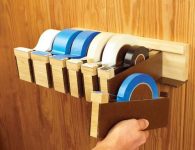

As I stood at a popular Portland trailhead, screwing the front wheel back on the Yamaha Wabash, friendly greetings from fellow cyclists morphed into skeptical stares when they saw the battery on my bike.
The whole concept of an electric gravel bike is a little strange. You can’t race with them and the whole point of biking is to increase your fitness and pit your strength against the great outdoors.
But on the other hand, is a motor really that different from an ultra-light carbon frame? If a motor makes your life easier and is more fun, why not? I’ve been dropped by my friends on many steep climbs as I huffed and puffed my way upward on a cheap steel mountain bike.
The Wabash is a double-header. It’s Yamaha’s entry into both the electric bike and gravel bike categories. It’s not built for speed. At 42 pounds, it’s pretty heavy and the electric assist only helps you get up to 20 mph. It can also get pretty jouncy over roads that are even slightly rough.
Yamaha
Yet, it also has rear rack mounts, a little bell, and an LED headlight. This is perfect for packing gear and a good utility commuter bike for anyone who shortens their 12-mile commute by cutting through a park. I’ve rode it around my neighborhood, as well as on gravel, dirt, and single-track trails around my house. I am this close to adding fenders and rolling off into the sunset with it.
It’s a Mash Up
A gravel bike looks like a mountain bike, performance road bike, and cyclocross bike were all cut up and sewn together—a zombie bicycle! It’s not light and sleek like a racer or burly and agile like an MTB, but a weird combination of both. It has a sturdy, hydroformed aluminum frame that comes in three sizes and one delicious latte color. It has drop handlebars for all-day riding comfort, and a bunch of other great specs.
For example, it has 11 speeds on a smooth SRAM Apex drivetrain, hydraulic disc brakes, and slim knobby Maxxis Speed Terrane tubeless tires, which are designed for grass and hard-packed trails. Like everything else about the bike, the tires promise versatility—and a compromise between speed, security, and comfort.
Yamaha has manufactured motors for a very long time, and it shows. The motor is mounted on a special spot on the down tube, to keep the weight as centered and low as possible. It has a four-hour charge time, and a shockingly long battery life. On a 20-mile ride with mild to moderate climbs on standard assistance, the battery only dropped by 10 percent.
Electric bike laws are pretty foggy, and vary wildly from state to state, but the Wabash is federally classified as a “class 1” electric bike, which means that it only assists you when you’re pedaling and will stop giving you assistance after you hit 20 mph. The bike’s computer uses data from the bike’s three sensors—a torque sensor to measure pedaling power, a speed sensor, and a crank sensor to measure RPMs— to figure out when to introduce assistance.
The tiny console is simple (and friendly! It blinks “See you” when you turn it off). It has two buttons, one to power the bike on and off and one for the headlight. While you’re riding, it shows you the battery life, whether the headlight is on, your speed, and your level of motor assist. There are four assistance levels, from Eco to High. Two small buttons by your left thumb let you switch up and down between them.
Climb Every Mountain
I used the Wabash to commute to bike shops and go to lunch. I also took it to a park where I’ve seen cyclocrossers covertly practicing in the past. The trails there are packed with hills and turns, with gravel double-wide track, asphalt, and dirt single track.
I had a great time. Drop handlebars are a little hard to control on twists and trails, but it was a joy to swoop up, down, and around, ringing the little bell so I didn’t knock over any dogs or pedestrians. Yamaha’s zero cadence feature means that the motor is triggered to provide assistance at even the slightest weight on the pedal, so you don’t need a throttle.
Yamaha
I could stop and restart on steep inclines on high assistance, and never felt the bike jerk away from me; the power assistance never felt like too much. Many lesser e-bikes have bashed me in the shins on less punishing rides.
A Jouncy, Bouncy Ride
I also took the Wabash to Leif Erickson Trail in Portland’s Forest Park. I’ve run on Leif Erickson hundreds of times over the years. It’s wide, made of mixed-gravel and asphalt—not exactly what I’d consider mountain-bike territory. I only meant to run down the battery life on a mellow 20-mile trail ride.
Unfortunately, I forgot that Leif Erickson does have a few sections where the rocks get larger than pea gravel. My arms (and back teeth) noticed the bike’s jounciness immediately. You may want to put bigger tires on the Wabash, if you ride on rough terrain. Most gravel bikes don’t have suspension in order to reduce the bike’s weight, but the Wabash already weighs 42 pounds. What’s a few more?
But as my colleague Stephanie Pearson noted, gravel bikers are a pretty nonconformist bunch and to argue over whether gravel bikes need front suspension is to descend into a very long internet rabbit hole. You can make a ton of modifications to a gravel bike, and there are many ways to ride one.
Imperfect, but Fun
The Yamaha Wabash is pretty heavy, and the motor doesn’t help you go very fast, because laws. But it was hard not to love it anyway. It’s the perfect style of bike for what I like to do: ride around my neighborhood, haul laundry to my kids’ school, and carry plenty of supplies for leisurely weekend bike packing trips.
It’s a bike that doesn’t take itself too seriously. On my way home one day, I passed two small kids in the park. They were pedaling crazily on their tiny mountain bikes in circles, over pavement, grass, and wood chips, going as fast as they could go. Riding the Wabash reminded me what that felt like, back when I had all the time and energy in the world to point myself down a trail and follow it all the way to the end.
If you’re switching between hard-packed dirt, grass, and asphalt, the Wabash is so much fun.
read more at https://www.wired.com/latest by Adrienne So
Tech








